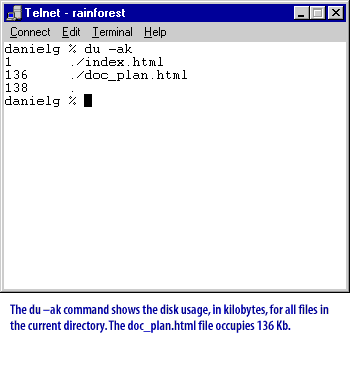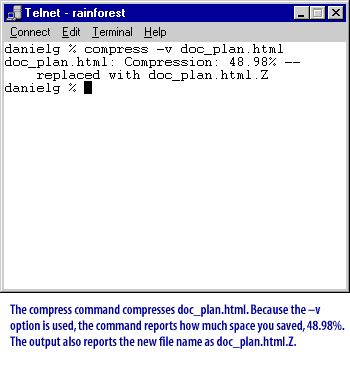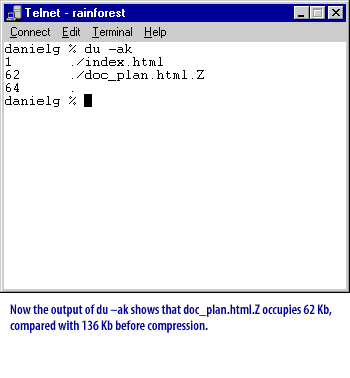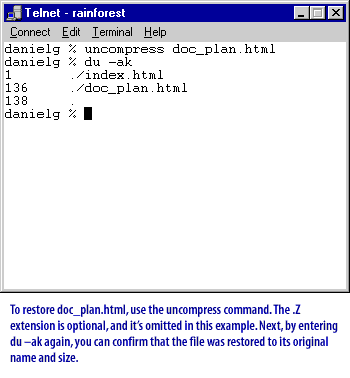| Lesson 3 | Compressing and uncompressing files |
| Objective | Use compress and uncompress to manage file sizes. |
Compressing and uncompressing Files in Unix
In modern Unix-based systems, `compress` and `uncompress` are still available but are largely considered outdated and less commonly used compared to newer tools like `gzip`, `bzip2`, and `xz`.
Key Points:
If you're managing files in a modern Unix system, you're more likely to encounter or prefer using tools like `gzip`, `bzip2`, `xz`, or even `zip` depending on your needs for compression ratio, speed, or compatibility.
Key Points:
- `compress` and `uncompress`** were among the earliest file compression tools in Unix, using the Lempel-Ziv Welch (LZW) algorithm.
- Drawbacks: They don't compress files as efficiently as modern alternatives like `gzip` (which uses the DEFLATE algorithm) or `xz` (which is more efficient in terms of compression ratio and speed).
- Compatibility: These tools may still be included in some Unix distributions or available for installation, mainly for backward compatibility.
If you're managing files in a modern Unix system, you're more likely to encounter or prefer using tools like `gzip`, `bzip2`, `xz`, or even `zip` depending on your needs for compression ratio, speed, or compatibility.
Compressing Files
File compression is a way of packing a file's contents more efficiently, so that the file takes up less space.
To compress files, enter the
This command also renames each file by adding a .Z extension[1] to the name. The
compress command and specify the file (or files) you want to act on, like this:% compress files
This command also renames each file by adding a .Z extension[1] to the name. The
compress command accepts a –v option, which is short for “verbose.” Use –v to display a status report that includes the original file name, the new file name, and the amount of compression that occurred. You can compress binary files or text files, but the result is always a binary file. This means you can’t read compressed files with commands such as cat or more.
- Restoring Files
To restore a compressed file to its original state, use theuncompresscommand:
% uncompress file.Z. You can omit the.Z extensionfrom the file name. Theuncompresscommand works either way. The following series of images shows some ways you can usecompressanduncompress.

Connect Edit Terminal Help danielg % du -ak 1 ./index.html 136 ./doc_plan.html 138 danielg %
Analysis of the Displayed Terminal Session:
- Telnet session: The terminal title indicates a Telnet connection to a server named "rainforest."
- Commands and Output:
- The command `du -ak` has been executed, which is used to display disk usage for all files in the current directory in kilobytes.
- The output lists two files: `index.html` and `doc_plan.html`, with sizes of 1 KB and 136 KB, respectively.
- A total size of 138 KB is indicated below the individual file sizes, suggesting the combined disk usage of the directory.
- User: The prompt "danielg %" indicates the session is being run by a user named "danielg."
This interface is typical of older Unix and Linux systems, indicating a focus on system administration or development tasks. The style of the interface suggests it may be from a retro or legacy system, often seen in environments that maintain older infrastructure for compatibility or specific needs.

Connect Edit Terminal Help danielg % compress -v doc_plan.html doc_plan.html: Compression: 48.98% — replaced with doc_plan.html.Z danielg %
Analysis of the Displayed Terminal Session:
- Telnet session: Like the previous image, this shows a session titled "rainforest," indicating the server or system being accessed.
- Command and Output:
- The `compress -v doc_plan.html` command has been executed. This command compresses the file `doc_plan.html`, and the `-v` (verbose) option provides detailed output about the compression.
- The output shows a compression ratio of 48.98%, indicating that the original file size has been reduced by nearly half.
- The original file is replaced with a compressed version named `doc_plan.html.Z`, following the convention of appending `.Z` to the file name for compressed files using the Unix `compress` utility.
- User: The session is managed by a user named "danielg", consistent with the previous session.
This session highlights a typical system administration task involving file compression to save disk space, often necessary in environments where storage optimization is crucial. The style and utility usage suggest an interaction with a Unix-like operating system, maintaining the focus on system-level operations and management.

danielg % du -ak 1 ./index.html 62 ./doc_plan.html.Z 64 danielg %
Analysis:
-
The
du -akcommand lists the disk usage of all files in the current directory in kilobytes.-a: Displays all files, not just directories.-k: Reports sizes in kilobytes.
-
Results:
- The file
index.htmloccupies 1 KB. - The compressed file
doc_plan.html.Zoccupies 62 KB. - The total disk usage of the directory is 64 KB.
- The file
-
Observation:
- Compression reduced the size of
doc_plan.htmlfrom 136 KB (as mentioned in the accompanying description) to 62 KB.
- Compression reduced the size of

danielg % uncompress doc_plan.html danielg % du -ak 1 ./index.html 136 ./doc_plan.html 138 danielg %
Analysis:
-
uncompresscommand:- The
uncompress doc_plan.htmlcommand restores the filedoc_plan.htmlfrom its compressed.Zformat back to its original state. - The
.Zextension is optional when using theuncompresscommand.
- The
-
du -akcommand:- The
du -akcommand lists the disk usage of all files in the current directory in kilobytes. - Results:
- The file
index.htmloccupies 1 KB. - The uncompressed file
doc_plan.htmlnow occupies 136 KB, which is its original size. - The total disk usage of the directory is 138 KB.
- The file
- The
-
Observation:
- The
uncompresscommand successfully restoreddoc_plan.htmlto its original name and size.
- The
How do I Use the commands compress and uncompress to manage file sizes in Unix
To compress a file in Unix, you can use the "compress" command followed by the name of the file you want to compress. For example, to compress a file named "file.txt", you would use the command:
This will create a new file called "file.txt.Z" which is the compressed version of the original file. To uncompress a file, you can use the "uncompress" command followed by the name of the compressed file. For example, to uncompress the file "file.txt.Z", you would use the command:
This will create a new file called "file.txt" which is the uncompressed version of the original file. Alternatively you can use the gzip command to compress and gunzip command to uncompress files with the following command :
Both compress and gzip are file compression utilities, however gzip is more commonly used.
In the next lesson, you will learn to view compressed files with
compress file.txt
This will create a new file called "file.txt.Z" which is the compressed version of the original file. To uncompress a file, you can use the "uncompress" command followed by the name of the compressed file. For example, to uncompress the file "file.txt.Z", you would use the command:
uncompress file.txt.Z
This will create a new file called "file.txt" which is the uncompressed version of the original file. Alternatively you can use the gzip command to compress and gunzip command to uncompress files with the following command :
gzip file.txtand
gunzip file.txt.gz
Both compress and gzip are file compression utilities, however gzip is more commonly used.
In the next lesson, you will learn to view compressed files with
zcat.
[1].Z extension: When you run the compress command, the resulting files are renamed to end with a .Z extension